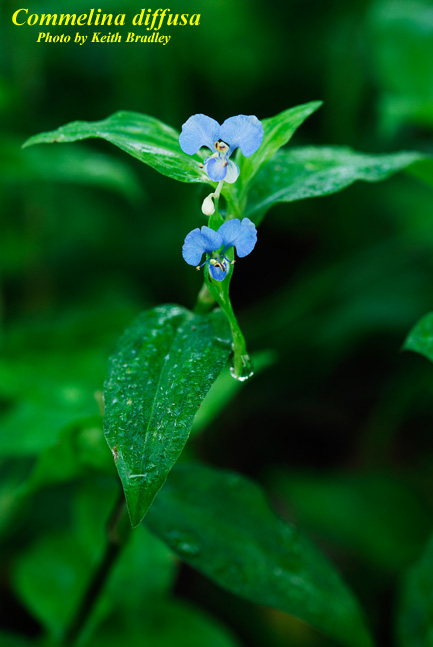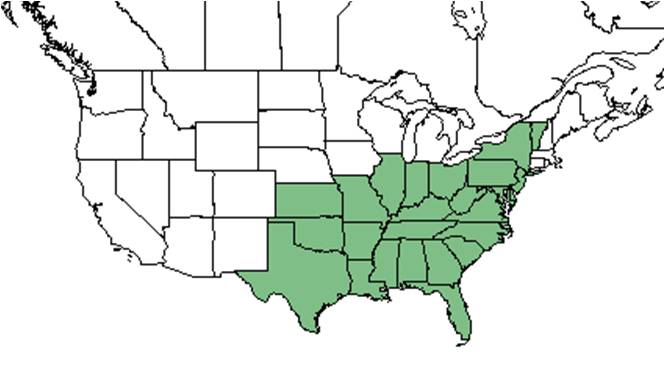Difference between revisions of "Commelina diffusa"
Krobertson (talk | contribs) (→Distribution) |
HaleighJoM (talk | contribs) (→Ecology) |
||
| (12 intermediate revisions by 7 users not shown) | |||
| Line 18: | Line 18: | ||
}} | }} | ||
| − | Common | + | Common names: Climbing dayflower; creeping dayflower |
==Taxonomic notes== | ==Taxonomic notes== | ||
| − | Synonyms: | + | Synonyms: ''C. longicaulis'' Jacquin; ''C. diffusa'' var. ''diffusa''.<ref name="weakley">Weakley, A.S. 2015. Flora of the southern and mid-atlantic states. Working Draft of 21 May 2015. University of North Carolina at Chapel Hill, Chapel Hill, North Carolina.</ref> |
| + | |||
| + | Varieties: none.<ref name="weakley">Weakley, A.S. 2015. Flora of the southern and mid-atlantic states. Working Draft of 21 May 2015. University of North Carolina at Chapel Hill, Chapel Hill, North Carolina.</ref> | ||
==Description== | ==Description== | ||
| Line 36: | Line 38: | ||
===Phenology=== | ===Phenology=== | ||
| − | Flowers are actinomorphic, blue, and have three fertile stamen and two staminoids<ref name="Invasive"/>. | + | Flowers are actinomorphic, blue, and have three fertile stamen and two staminoids.<ref name="Invasive"/> ''C. diffusa'' has been observed flowering from April through October with peak inflorescence in September and October and fruits April through September.<ref>Nelson, G. [http://www.gilnelson.com/ PanFlora]: Plant data for the eastern United States with emphasis on the Southeastern Coastal Plains, Florida, and the Florida Panhandle. www.gilnelson.com/PanFlora/ Accessed: 7 DEC 2016</ref><ref name="FSU Herbarium"/> |
===Seed dispersal=== | ===Seed dispersal=== | ||
| Line 46: | Line 48: | ||
===Pollination=== | ===Pollination=== | ||
| − | + | ''Commelina diffusa'' has been observed at the Archbold Biological Station to host sweat bees from the Halictidae family such as ''Agapostemon splendens, Augochlorella gratiosa'' and ''Lasioglossum pectoralis''.<ref name="Deyrup 2015">Deyrup, M.A. and N.D. 2015. Database of observations of Hymenoptera visitations to flowers of plants on Archbold Biological Station, Florida, USA.</ref> | |
| − | |||
| − | |||
| − | === | + | ===Herbivory and toxicology=== |
The larva of the moth, ''Mouralia tinctoides'', has been observed developing on ''C. diffusa''.<ref name="Landolt 1993">Landolt, Peter J. 1993. Suitability of six species of Commelinaceae as larval hosts of ''Mouralia tinctoides'' (Lepidoptera: Noctuidae, Plusiinae). The Florida Entomologist 76(4):572–576.</ref> | The larva of the moth, ''Mouralia tinctoides'', has been observed developing on ''C. diffusa''.<ref name="Landolt 1993">Landolt, Peter J. 1993. Suitability of six species of Commelinaceae as larval hosts of ''Mouralia tinctoides'' (Lepidoptera: Noctuidae, Plusiinae). The Florida Entomologist 76(4):572–576.</ref> | ||
| Line 56: | Line 56: | ||
Larva from ''Liromyza commelinae'' infests ''C. diffusa'' by creating distinct serpentine mines on the upper surface of the leaves.<ref name="Stegmaier 1966">Stegmaier, Carl E.. 1966. ''Liriomyza commelinae'', a leaf miner on ''Commelina'' in Florida (Diptera, Agromyzidae). The Florida Entomologist 49(3): 147–149.</ref> | Larva from ''Liromyza commelinae'' infests ''C. diffusa'' by creating distinct serpentine mines on the upper surface of the leaves.<ref name="Stegmaier 1966">Stegmaier, Carl E.. 1966. ''Liriomyza commelinae'', a leaf miner on ''Commelina'' in Florida (Diptera, Agromyzidae). The Florida Entomologist 49(3): 147–149.</ref> | ||
| − | ==Conservation and | + | ==Conservation, cultivation, and restoration== |
| − | Stolons can be cut into small pieces and easily regenerate, making it difficult to control. Herbicide has been observed to have a relatively low effect on ''Commelina''<ref name="Invasive"/> | + | Stolons can be cut into small pieces and easily regenerate, making it difficult to control. Herbicide has been observed to have a relatively low effect on ''Commelina.''<ref name="Invasive"/> |
| − | + | In the United States, it is a major weed in rice crops and reduces rice grain yields. It is abundant in late July and early August, after the first rice crop has been harvested and when the second crop is watered and fertilized, making it difficult to remove.<ref name="Roy 1984">Roy J. Smith, Jr. 1984. Competition of spreading dayflower (''Commelina diffusa'') with rice (''Oryza sativa''). Weed Science 32(1): 116–119.</ref> It is also a weed in soybean crops.<ref name="Invasive"/> | |
| − | + | ==Cultural use== | |
| − | In the United States, it is a major weed in rice crops and reduces rice grain yields. It is abundant in late July and early August, after the first rice crop has been harvested and when the second crop is watered and fertilized, making it difficult to remove.<ref name="Roy 1984">Roy J. Smith, Jr. 1984. Competition of spreading dayflower (''Commelina diffusa'') with rice (''Oryza sativa''). Weed Science 32(1): 116–119.</ref> It is also a weed in soybean crops <ref name="Invasive"/> | ||
| − | |||
==Photo Gallery== | ==Photo Gallery== | ||
<gallery widths=180px> | <gallery widths=180px> | ||
Latest revision as of 08:57, 22 June 2022
| Commelina diffusa | |
|---|---|

| |
| Photo by Keith Bradley, Atlas of Florida Vascular Plants | |
| Scientific classification | |
| Kingdom: | Plantae |
| Division: | Magnoliophyta - Flowering plants |
| Class: | Liliopsida – Monocotyledons |
| Order: | Commelinales |
| Family: | Commelinaceae |
| Genus: | Commelina |
| Species: | C. diffusa |
| Binomial name | |
| Commelina diffusa Burm. f. | |

| |
| Natural range of Commelina diffusa from USDA NRCS Plants Database. | |
Common names: Climbing dayflower; creeping dayflower
Contents
Taxonomic notes
Synonyms: C. longicaulis Jacquin; C. diffusa var. diffusa.[1]
Varieties: none.[1]
Description
A description of Commelina diffusa is provided in The Flora of North America
C. diffusa is an annual species in temperate climates and is either an annual or perennial in tropical and subtropical climates.[2] Species of the genera Commelina can be separated from those of Tradescantia by having unequal petals, one is distinctly smaller.[3] Leaves are alternately arranged and develop along the nodes.[4] Flowers are actinomorphic, blue, and have three fertile stamens and two staminoids.[2]
Distribution
Distribution is not limited to the Southeastern United States, it can also be found in Africa, Asia, South America, Australia, and South Asian islands.[5]
Ecology
Habitat
C. diffusa can be found at loamy lake shores; sandy loam of floodplains; seasonally flooded cypress domes; annually burned pine savannas; loamy sand in mesic flatwoods; wet margins of wax myrtle thickets; and pine-oak-beech-magnolia forests.[6] It has occurred in disturbed areas such as the banks of artificially filled lakes, lawns, roadsides, orange tree groves, unpaved parking lots, levees and ditches. It has been observed growing in loamy sand, sandy loam, oyster shell soil, and alluvial soils.[6]
Phenology
Flowers are actinomorphic, blue, and have three fertile stamen and two staminoids.[2] C. diffusa has been observed flowering from April through October with peak inflorescence in September and October and fruits April through September.[7][6]
Seed dispersal
The fruit is a five seeded capsule with one seed indehiscent in the dorsal locule and two dehiscent seeds in the ventral locule.[8]
Fire ecology
Following a fire, adults will resprout basally.[9]
Pollination
Commelina diffusa has been observed at the Archbold Biological Station to host sweat bees from the Halictidae family such as Agapostemon splendens, Augochlorella gratiosa and Lasioglossum pectoralis.[10]
Herbivory and toxicology
The larva of the moth, Mouralia tinctoides, has been observed developing on C. diffusa.[11]
Diseases and parasites
Larva from Liromyza commelinae infests C. diffusa by creating distinct serpentine mines on the upper surface of the leaves.[12]
Conservation, cultivation, and restoration
Stolons can be cut into small pieces and easily regenerate, making it difficult to control. Herbicide has been observed to have a relatively low effect on Commelina.[2] In the United States, it is a major weed in rice crops and reduces rice grain yields. It is abundant in late July and early August, after the first rice crop has been harvested and when the second crop is watered and fertilized, making it difficult to remove.[13] It is also a weed in soybean crops.[2]
Cultural use
Photo Gallery
References and notes
- ↑ 1.0 1.1 Weakley, A.S. 2015. Flora of the southern and mid-atlantic states. Working Draft of 21 May 2015. University of North Carolina at Chapel Hill, Chapel Hill, North Carolina.
- ↑ 2.0 2.1 2.2 2.3 2.4 [Invasive species compendium]Accessed: December 9, 2015
- ↑ Wunderlin, Richard P. and Bruce F. Hansen. Guide to the Vascular Plants of Florida. Second edition. 2003. University Press of Florida: Gainesville/Tallahassee/Tampa/Boca Raton/Pensacola/Orlando/Miami/Jacksonville/Ft. Myers. 412-13.
- ↑ [Go botany] Accessed: December 9, 2015
- ↑ Holm LG, Plucknett DL, Pancho JV, Herberger JP, 1977. The World's Worst Weeds. Distribution and Biology. Honolulu, Hawaii, USA: University Press of Hawaii.
- ↑ 6.0 6.1 6.2 Florida State University Robert K. Godfrey Herbarium database. URL: http://herbarium.bio.fsu.edu. Last accessed: October 2015. Collectors: Loran C. Anderson, D. Burch, Mireya D. Correa, Dianne Hall, Ed Keppner, Lisa Keppner, R. Komarek, Horace Loftin, R.L. Lazor, Karen MacClendon, Travis MacClendon, R.A. Norris, Kim Ponzio, Dana Sakole, Cecil R. Slaughter, Edwin L. Tyson. States and Counties: Florida: Bay, Brevard, Calhoun, Flagler, Franklin, Gadsden, Jackson, Jefferson, Lee, Leon, Madison, Nassau, Polk, Santa Rosa, St. Johns, Volusia, Wakulla. Georgia: Grady. Country: Panama. Compiled by Tall Timbers Research Station and Land Conservancy. Associated species include Alternanthera, Polygonum, Carex, Hypoxis curtissii, Paspalum, Panicum, Alternanthera, Ludwigia, Murdannia, and Hydrolea.
- ↑ Nelson, G. PanFlora: Plant data for the eastern United States with emphasis on the Southeastern Coastal Plains, Florida, and the Florida Panhandle. www.gilnelson.com/PanFlora/ Accessed: 7 DEC 2016
- ↑ Faden, Robert B. 1993. The misconstrued and rare species of Commelina (Xommelinaceae) in the eastern United States”. Annals of the Missouri Botanical Garden 80(1):208–218.
- ↑ [Fire Responses of Commelina diffusa]Accessed: December 9, 2015
- ↑ Deyrup, M.A. and N.D. 2015. Database of observations of Hymenoptera visitations to flowers of plants on Archbold Biological Station, Florida, USA.
- ↑ Landolt, Peter J. 1993. Suitability of six species of Commelinaceae as larval hosts of Mouralia tinctoides (Lepidoptera: Noctuidae, Plusiinae). The Florida Entomologist 76(4):572–576.
- ↑ Stegmaier, Carl E.. 1966. Liriomyza commelinae, a leaf miner on Commelina in Florida (Diptera, Agromyzidae). The Florida Entomologist 49(3): 147–149.
- ↑ Roy J. Smith, Jr. 1984. Competition of spreading dayflower (Commelina diffusa) with rice (Oryza sativa). Weed Science 32(1): 116–119.